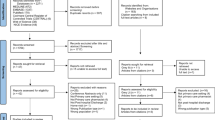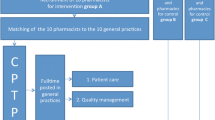Abstract
Objective
Assessing the relevance of a clinically active pharmacist method compared to the traditional working method.
Method
The study was carried out in a general internal/gastro-enterology unit during two 8-weeks periods in 2004. It was an observational, non-randomized prospective study. Outcome measures were compared before and during the intervention. The intervention was the active presence of a junior hospital pharmacist on the unit. The pharmacist focused on the pharmacotherapy of the individual patient. Patients were included when they used 5 or more medicines on day 1 or 2 of their stay at the ward and/or used at least 1 high-risk drug. Clinical pharmacist interventions were counted and classified. A hospital pharmacist and an internal medicine specialist assessed the clinical relevance of all clinical pharmacist interventions retrospectively. The degree of acceptance of the interventions by physicians was measured. Finally, time associated with the clinical activities was measured.
Main outcome measures
Number of interventions (related to number of medication orders), clinical relevance and degree of acceptance.
Results
In the pre-intervention period 79 patients were included versus 84 in the during-intervention period. About 82 interventions in the pre-intervention period were made compared to 173 during the during-intervention period. There was little agreement between the professional raters (weighted κA–E = 0.30 and weighted κ1–5 = 0.20). Nevertheless both ratings showed a substantial increase of clinically relevant interventions. The number of interventions accepted by the physician increased from 16 in the pre-intervention period to 75 in the during-intervention period. Working with this method took over 4 h a day.
Conclusion
Clinical pharmacy services provided by a junior hospital pharmacist on an internal medicine ward contribute to rationalization of drug therapy and are therefore likely to increase medication safety.

Similar content being viewed by others
References
Van den Bemt PMLA, Egberts TCG, de Jong-van den Berg LTW, Brouwers JRBJ. Drug-related problems in hospitalised patients. Drug Saf. 2000;22(4):321–33.
Lustig A. Medication error prevention by pharmacists- An Israeli solution. Pharm World Sci 2000;22(1):21–5.
Kucukarslan SN, Peters M, Mlynarek M, Nafziger DA. Pharmacists on rounding teams reduce preventable adverse drug events in hospital general medicine units. Arch Intern Med 2003;163:2014–7.
Scarsi KK, Fotis MA, Noskon GA. Pharmacist participation in medical rounds reduces medication errors. Am J Health Syst Pharm 2002;59:2089–92.
Leape LL, Cullen DJ, Clapp MD, Burdick E, Demonaco HJ, Erickson JI, Bates DW. Pharmacist Participation on physician rounds and adverse drug events in the intensive care unit. JAMA 1999;282(3):267–70.
Calvert RT. Clinical pharmacy- a hospital perspective. Br J Clin Pharmacol 1999;47:231–8.
Hawksworth GM, Corlett AJ, Wright DJ, Chrystyn H. Clinical pharmacy interventions by community pharmacists during the dispensing process. Br J Clin Pharmacol. 1999;47(6):695–700.
Needham DS, Wong IC, Campion PD. Evaluation of the effectiveness of UK community pharmacists’ interventions in community palliative care. Palliat Med. 2002;16(3):219–25.
Buurma H, De Smet PA, Leufkens HG, Egberts TCG. Evaluation of the clinical value of pharmacists’ modifications of prescription errors. Br J Clin Pharmacol. 2004;58(5):503–11.
Buurma H, de Smet PA, van den Hoff OP, Egberts TCG. Nature, frequency and determinants of prescription modifications in Dutch community pharmacies. Br J Clin Pharmacol 2001;52(1):85–91.
Van den Bemt PMLA, Egberts ACG, Lenderink AW, Verzijl JM, Simons KA, van der Pol WSJCM, Leufkens HGM. Risk factors for the development of adverse drug events in hospitalized patients. Pharm World Sci 2000;22(2):62–6.
Fick DM, Cooper JW, Wade WE, Waller JL, Maclean JR, Beers MH. Updating the Beers criteria for potentially inappropriate medication use in older adults. Results of a USA consensus panel of experts. Arch Intern Med 2003;163:2716–24.
American Society of Health System Pharmacists (ASHP) “Clinical Skills Program”, module 3–5, 1993.
Overhage M, Lukes A. Practical, reliable, comprehensive method for characterizing pharmacists’ clinical activities. Am J Health Syst Pharm 1999; 56(23):2444–50.
Dutch Scientific Institute for Pharmacy Dutch manual for drug substitution, May 2004. www. WINAp.nl.
McLeod PJ, Huang AR, Tamblyn RM, Gayton DC. Defining inappropriate practices in prescribing for elderly people: a national consensus panel. Can Med Assoc J 1997;156:385–91.
Van den Bemt PMLA. Costs and benefits of detecting prescribing errors. Thesis: Drug safety in hospitalised patients. Rijksuniversiteit Groningen 2002;Ch 4.2:75–88.
Boyko WL Jr, Yurkowski PJ, Ivey MF, Armitstead JA, Roberts BL. Pharmacist influence on economic and morbidity outcomes in a tertiary care teaching hospital. Am J Health Syst Pharm 1997;54(14):1591–5.
Schumock GT, Butler MG, Meek PD, Vermeulen LC, Arondekar BV, Bauman JL. Evidence of the economic benefit of clinical pharmacy services: 1996–2000. Pharmacotherapy 2003;23(1):113–32.
Van Roon EN, Wu MD, Idzinga F, Van den Bemt PMLA, Jansen TLTA, Houtman PM, Van de Laar, MAFJ, Brouwers JRBJ. A multidisciplinary approach for the assessment of drug interactions with disease-modifying antirheumatic drugs. Thesis Groningen University 2005: Practice research in the field of rheumatoid arthritis.
Dale A, Copeland R, Barton R. Precribing errors on medical wards and the impact of clinical pharmacists. Int J Pharm Pract 2003;11:19–24.
Acknowledgments
We would very much like to thank dr. A.M.L. Kerremans (internal medicine specialist/clinical pharmacologist) for rating all interventions. Likewise we like to thank the junior doctors, internal medicine specialists and nurses of the internal medicine ward A2, location Sophia, Isala klinieken for participating in this study.
Author information
Authors and Affiliations
Corresponding author
Rights and permissions
About this article
Cite this article
Bosma, L., Jansman, F.G.A., Franken, A.M. et al. Evaluation of pharmacist clinical interventions in a Dutch hospital setting. Pharm World Sci 30, 31–38 (2008). https://doi.org/10.1007/s11096-007-9136-9
Received:
Accepted:
Published:
Issue Date:
DOI: https://doi.org/10.1007/s11096-007-9136-9




